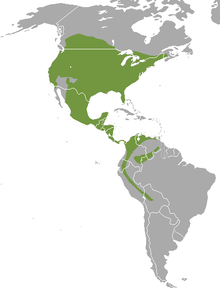Long-tailed weasel
| Long-tailed weasel | ||||||||||||
|---|---|---|---|---|---|---|---|---|---|---|---|---|

Long-tailed weasel |
||||||||||||
| Systematics | ||||||||||||
|
||||||||||||
| Scientific name | ||||||||||||
| Mustela frenata | ||||||||||||
| Lichtenstein , 1831 |
The long-tailed weasel ( Mustela frenata ) is a species of predator from the marten family (Mustelidae). It is native to the American continent and is closely related to the ermine .
description
Long-tailed weasels have the typical physique of the weasel with the elongated, slender body and the relatively short limbs. They resemble the ermine in their fur color and dimensions, but differ in their longer, bushier tail. In the northern part of their range they are also subject to the change of coat . Their fur is brown on the upper side, the underside is yellowish-white and the tip of the tail is black. The winter fur is pure white except for the tip of the tail. These animals reach a head body length of 20 to 30 centimeters, a tail length of 8 to 20 centimeters and a weight of 90 to 360 grams.
distribution and habitat
The distribution area of the long-tailed weasel extends from southern Canada over the USA and Central America to Guyana and Bolivia ; in the extreme north it overlaps with that of the ermine. They inhabit different habitats, but prefer open, bush-covered grasslands, mostly near bodies of water. They can also be found at the edges of forests or on agricultural land, but avoid dense forests and overly dry terrain.
Way of life
Although they sometimes go looking for food during the day, they are mostly nocturnal. As resting places, they create nests in hollow tree trunks, crevices in the rock or abandoned buildings of other animals, the nests are lined with fur. They live solitary and are territorial. The territories can overlap, especially that of a male with that of females, but they usually avoid each other.
food
Long-tailed weasels are nimble, skilled hunters. Their slim body allows them to climb into small animal burrows or through narrow slits in fences. When hunting, they stay mostly on the ground, they are not very good at climbing. They use their well-developed sense of hearing and smell to localize their prey .
These animals feed primarily on small mammals , especially mice and other rodents . They also prey on cottontail rabbits , birds and reptiles .
Reproduction
The mating takes place in July or August, due to a dormancy , the fertilized egg does not implant until the following March. The actual gestation period is around 27 days; three to nine (an average of six) young are born in April or May. These are initially blind and helpless, but grow very quickly and are weaned at around 36 days. Females reach sexual maturity at three to four months and can reproduce in their first year of life, while males reach sexual maturity at around one year.
Long-tailed weasel and people
Sometimes long-tailed weasels break into stables and tear down poultry, but since rodents, which are primarily regarded as pests , are among their prey, they are rather popular. Their fur, especially the white winter fur (see ermine fur and weasel fur), is processed into fur clothing, but to a much lesser extent than, for example, the closely related ermine . Overall, they are widespread and are not endangered species.
literature
- Ronald M. Nowak: Walker's Mammals of the World . 6th edition. Johns Hopkins University Press, Baltimore 1999, ISBN 0-8018-5789-9 (English).
Web links
- Mustela frenata in the endangered Red List species the IUCN 2008. Posted by: F. Reid, K. slipway, 2008. Accessed on January 1 of 2009.

